The Canal des Deux Mers: linking the Mediterranean Sea and the Atlantic Ocean
Pierre-Paul Riquet's dream was to create a link between the Mediterranean Sea and the Atlantic Ocean. This was a strategic route for the transport of goods and people, but the Canal des Deux Mers fell into disuse when the railroad was built between Bordeaux and Sète. Never mind that small detail however…
With its impressive engineering structures, historic route and bucolic banks, the Canal des Deux Mers is one of today's main tourist attractions in France.
What exactly is the Canal des Deux Mers?
The Canal du Midi and the Canal de Garonne combined.
We call the canal that links the Mediterranean Sea and the Atlantic Ocean the Canal des Deux-Mers (Canal of the Two Seas), but this canal is in fact two canals combined.
The Canal du Midi: 240 km long, starts in Toulouse and flows as far as the Thau lagoon.
The Canal de Garonne: 173 km long, between Toulouse and Castets-en-Castillon, on the Garonne river, upstream from Bordeaux.
The Canal du Midi was built in 1681 by Pierre-Paul Riquet. It was Riquet's dream to link the Atlantic to the Mediterranean and the Canal du Midi made this dream come true, using the Garonne to reach the Atlantic Ocean from Toulouse.
The Canal de Garonne: an extension of the Canal du Midi between Toulouse and the Atlantic Ocean
Difficult to navigate on the Garonne river
From the construction phase of the Canal du Midi, Pierre-Paul Riquet had planned to extend the waterway towards Bordeaux, alongside the Garonne river.
Why next to the Garonne river? Because this river was well-known for its capricious waters and fluctuating flow meaning that it was not possible to sail here all year round. In winter, the water level increased a lot, and in the summer, the level was low.
But the cost of building the Canal du Midi alone meant that Riquet's project was not accepted, and he gave up.
Therefore, up until the industrial revolution, goods were transported from the Mediterranean to the Atlantic Ocean along the Garonne river. In Toulouse, the canal boats from the Canal du Midi were unloaded, and this load was transferred over to other more lightweight boats. These boats were therefore better adapted to sailing on the river.
But the final conclusion was still the same, in that the very unpredictable conditions for sailing meant that it took longer and this in turn generated higher transport costs. At the beginning of the 19th century, the plans to build a canal alongside the Garonne river were once again put forward… And this time, the project was accepted!
The Canal de Brienne, the main water inlet for the new side canal
In 1776, in Toulouse, the inauguration of the Canal de Brienne meant that the Canal du Midi could be linked to the Garonne river upstream from the Bazacle. This connection made any exchanges between the Garonne and the canal much easier.
In the 19th century, the Canal de Brienne became the main water inlet, supplying water to the Canal de Garonne. The waters from the Garonne river that passed through were filtered via the Bassin des Filtres.
The beginning of construction work on the Canal de Garonne
In 1828, the Compagnie Magendie from Bordeaux was commissioned to study the route and feasibility of a canal alongside the Garonne river.
Two years later, the company requested that Jean-Baptiste de Baudre, civil engineering divisional inspector, carry out a technical study to assess the possibility of supplying the canal with waters from the Garonne, and then from 1839, the construction of this canal.
Construction work began simultaneously in different locations. The highlight of this new project was when the Duke of Orleans placed the first stone of Agen aqueduct.
The Canal de Garonne route
Considering the topography along the Garonne plain, the side canal features much less bends than the Canal du Midi. It runs along the right banks of the river from Toulouse to Agen, and along the left banks from Agen to Castets-en-Castillon, and crosses the Garonne river via Agen aqueduct.
Just like the Canal du Midi, the side canal runs along the outskirts of the towns it passes by: Montech, Moissac, Agen. It is also connected to the navigable rivers of the Aquitaine region (Baïses, Lot via the Garonne and Tarn) via locks.
Opened for navigation in 1844, the Canal de Montech was built at the same time as the side canal. This one connects the town of Montauban and the Tarn river (navigable as far as Albi) to the side canal.
The emergence of the railroad
In 1850, even though construction work on the canal wasn't finished, plans emerged to create a railroad between Toulouse and Bordeaux. Faced with this new emerging means of transport, a question arose: should work on the Canal de Garonne (side canal) continue?
The State decided to go ahead with construction work. The same company was commissioned to carry out both the work to build the railroad and the canal, simultaneously: the 'Compagnie des chemins de fer du Midi et du canal latéral à la Garonne'. This company was run by the Pereire brothers.
On 12 May 1856, the canal was inaugurated between Toulouse and Castets-en-Castillon in Gironde. In August 1856, the railroad was completed between Bordeaux and Toulouse.
The Canal des Deux Mers today
There was obviously a conflict of interest, and the 'Compagnie des chemins de fer du Midi et du canal latéral à la Garonne' set the same cost for river transport and rail transport. As you can imagine, this decision was the beginning of a decline in water transport and consequently, a decline in the use of the side canal.
Worse still… On 29 May 1858, the Compagnie signed the same contract for the use of the Canal du Midi, which meant the canal experienced the same problem as the side canal, and fell into disuse.
Following this disastrous management of the Canal des Deux Mers, the State purchased the Canal des Deux-Mers from the Compagnie des chemins de fer in 1897, and attempted - in vain - to revive navigation by doing away with navigation charges.
The State decided to modernise the canal in the 1970s, in another attempt to revive water transport. The locks were modified in accordance with the Freycinet gauge and the Montech water slope was created to by-pass the series of five locks and save time.
But the outcome wasn't as positive as expected. From the 1990s, navigation on the side canal and the Canal du Midi became solely recreational. Today, most of the locks on the Canal de Garonne are automated.
There is now a cycle route, Canal des Deux-Mers by bike, to cycle between the Mediterranean and the Atlantic alongside the Canal du Midi and the Canal de Garonne.













